Archived Blog Posts
How to Tell if You Have Mold in Your Home
5/14/2023 (Permalink)
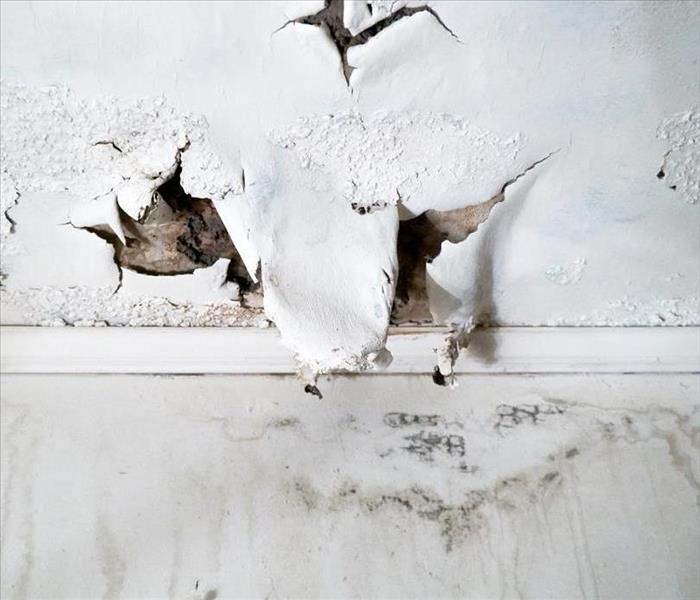 Identifying mold in your home is an important first step in addressing the problem.
Identifying mold in your home is an important first step in addressing the problem.
Mold is a common problem in many homes, and it can cause a variety of issues if left untreated. While it's important to address mold growth for health reasons, it's also important to identify it early so that it can be removed before it causes serious damage to your home. Here are some ways to tell if you have mold in your home.
Visible Mold
The most obvious sign of mold is seeing it. It can appear black, green, white, or even pinkish in color, and it can grow on any surface that is damp or has high humidity. Check areas like walls, ceilings, floors, and even furniture for signs of mold growth.
Musty Odor
Mold has a distinct musty odor that is difficult to miss. If you notice a strong, musty smell in your home, it's likely that there is mold growing somewhere. This odor is caused by the mycotoxins that mold produces, and it can be an indication that there is a significant mold problem.
Water Damage
Mold thrives in damp environments, so if you've had any recent water damage in your home, it's important to inspect the area for signs of mold growth. Water damage can occur from leaks, floods, or even high humidity levels.
Discoloration
Mold can cause discoloration on surfaces such as walls, ceilings, and floors. This can appear as yellow, brown, or even greenish stains, and it's a sign that there may be mold growing behind the surface.
Remediation and Prevention
If you suspect that you have mold in your home, it's important to address it as soon as possible. While there are DIY methods to remove small amounts of mold, it's best to contact a professional, such as SERVPRO of Oakville/Mehlville for larger infestations or for mold growth in hard-to-reach areas. A professional mold remediation company can assess the extent of the problem, remove the mold safely and efficiently, and take steps to prevent future mold growth.
In addition to removing mold, it's important to take steps to prevent it from growing in the first place. This can include reducing humidity levels in your home by using a dehumidifier or improving ventilation, fixing any leaks or water damage as soon as possible, and cleaning up spills or standing water immediately.
Taking Action Against Mold
Identifying mold in your home is an important first step in addressing the problem. By being vigilant and taking action as soon as possible, you can keep your home safe and healthy for you and your family.
Protecting Your Property After a Fire: How SERVPRO's Emergency Board Up Services Can Help
4/16/2023 (Permalink)
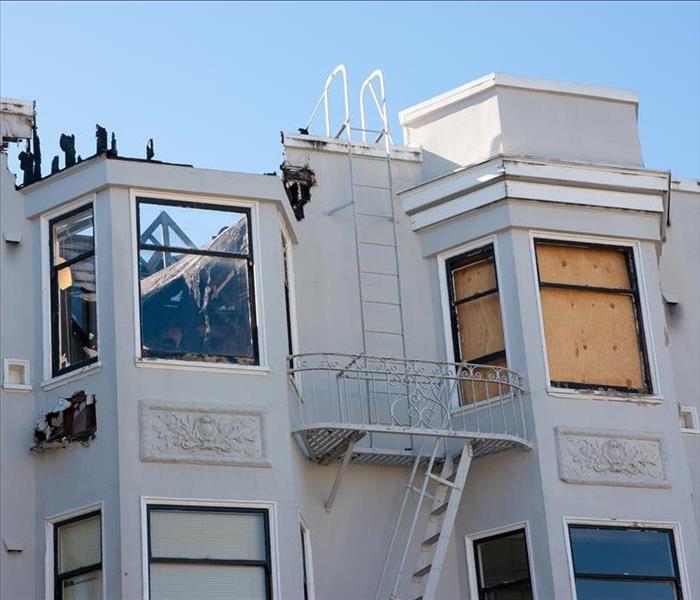 Emergency board-up services are essential after a fire or other disaster.
Emergency board-up services are essential after a fire or other disaster.
After a fire, one of the most crucial steps in the restoration process is emergency board-up services. Emergency board-up is the process of securing and protecting a property after a fire, flood, or other disasters. It involves boarding up windows, doors, and other openings to prevent further damage to the property and protect it from potential theft or vandalism.
SERVPRO of Oakville/Mehlville, a leading provider of fire and water damage restoration services, offers emergency board-up services to homeowners and businesses affected by disasters. Here's what you need to know about emergency board up and how SERVPRO of Oakville/Mehlville can help.
Why is Emergency Board Up Important?
Emergency board-up is important for several reasons. First, it helps protect the property from further damage. After a fire, water, and smoke damage can continue to spread and cause additional harm to the structure and contents of the property. By boarding up windows and doors, SERVPRO can prevent these elements from entering the property and causing further damage.
Second, emergency board up helps deter theft and vandalism. When a property is left unsecured after a fire, it is vulnerable to looting and vandalism. By boarding up the property, SERVPRO can discourage potential thieves and vandals from entering and causing further damage.
Finally, emergency board-up is important for safety reasons. After a fire, the structural integrity of a property can be compromised. Boarding up the property helps prevent anyone from entering and getting injured due to unstable structures or debris.
How SERVPRO Offers Emergency Board-Up Services
SERVPRO of Oakville/Mehlville offers emergency board-up services as part of its comprehensive fire damage restoration services. Their team of trained and certified professionals is available 24/7 to respond to emergencies and provide immediate assistance.
When you call SERVPRO for emergency board-up services, they will send a team to your property to assess the damage and begin the board-up process. They will start by securing the property and identifying any potential hazards. Then, they will board up all windows, doors, and other openings to prevent further damage and protect the property. With SERVPRO of Oakville/Mehlville’s expertise and experience in emergency board-up services, you can trust that your property is in good hands.
In addition to emergency board-up services, SERVPRO of Oakville/Mehlville also offers other fire damage restoration services, including smoke and soot damage cleanup, water damage restoration, and content cleaning and restoration. Their goal is to restore your property to its preloss condition as quickly and efficiently as possible.
In conclusion, emergency board-up services are essential after a fire or other disaster. They help protect the property from further damage, deter theft and vandalism, and promote safety. If you've experienced a fire or other disaster, contact SERVPRO of Oakville/Mehlville to learn more about their emergency board-up and restoration services.
Most Common Reasons Your Washing Machine Is Leaking Water
3/16/2023 (Permalink)
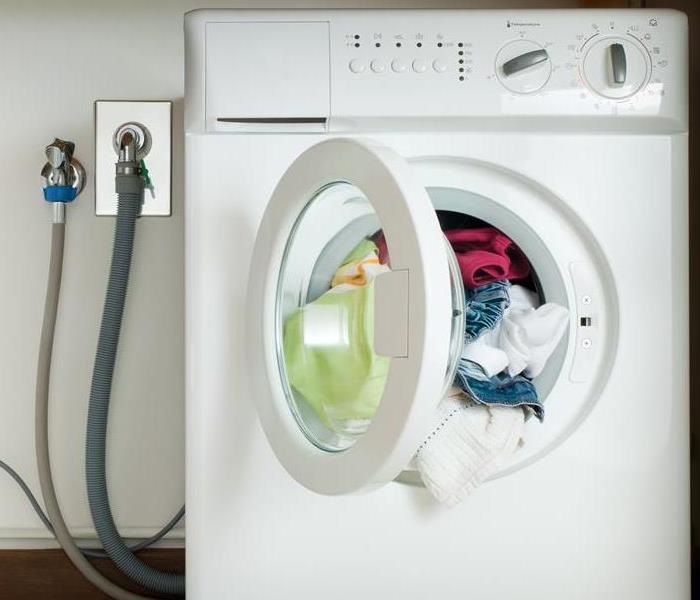 Noticing an usual sound with the washer could be a sign of malfunction.
Noticing an usual sound with the washer could be a sign of malfunction.
An improperly functioning washing machine can be a major inconvenience. If you're noticing an unusual amount of water leaking from your washing machine, it may be time to have it repaired by a technician. There are many reasons why this could happen, but fortunately, they're most often easily fixed by a qualified technician who can inspect your machine and make any necessary repairs. Here are some common causes of washing machine leaks:
The Hose Clamp Needs Tightening or Replacement
If you're experiencing a leak from your washing machine, the first thing to check is whether or not the hose clamp needs tightening or replacement. A hose clamp is a metal band that wraps around the hose to prevent it from leaking. If your washing machine hoses are loose and leaking water, tighten them with pliers before replacing them completely if they continue to leak after being tightened.
Tub Seal is Damaged
The tub seal is the rubber seal that separates the outer drum of your washing machine from its inner spin basket. This is one of the most common reasons for leaks in a washer, as it can become damaged over time or even break completely if you're not careful when loading laundry into your machine.
If your tub seal becomes damaged, water will leak from around the rim of your washing machine during spin cycles and can cause damage to walls and floors underneath it. Fortunately, this part is easy to replace.
Faulty Water Pump
The water pump is the motor that pumps water through the system, and it's usually located in the back of your machine. The most common type of water pump is a belt-driven motor that uses rubber belts to transfer power from its shaft to other components like pumps or motors within the unit. If any one of these parts fails, you'll start seeing leaks around where they're located--usually at joints or seams where two pieces meet up together. If you suspect damage from this cause and want help identifying what needs replacing before buying new parts, call us today!
A leak from the Drain Hose
If you notice water leaking from the washing machine, it could be coming from the drain hose. This is a tube that connects your washing machine to your home's drain pipe and carries away any excess water during use.
In some cases, damage or wear-and-tear can cause the hose to leak; in others, corrosion may have built up on its interior walls over time, this is especially common when using harsh detergents.
The Washing Machine is Unleveled
If your washing machine is leaking water and you've checked the hoses and pipes, it's likely that your laundry room floor is uneven. The most common cause of this issue is when a washing machine has been moved from one place to another, but it can also happen during installation.
Call A Professional For Assistance
If you're noticing an unusual amount of water leaking from your washing machine, it may be time to have it repaired by a technician. If your washing machine has been leaking water for an extended period of time, or if a sudden burst of water leaked out of your washing machine and damaged your laundry room, call SERVPRO Oakville/Mehlville for all your water damage cleanup and restoration needs!
What to do when your toilet overflows
2/5/2023 (Permalink)
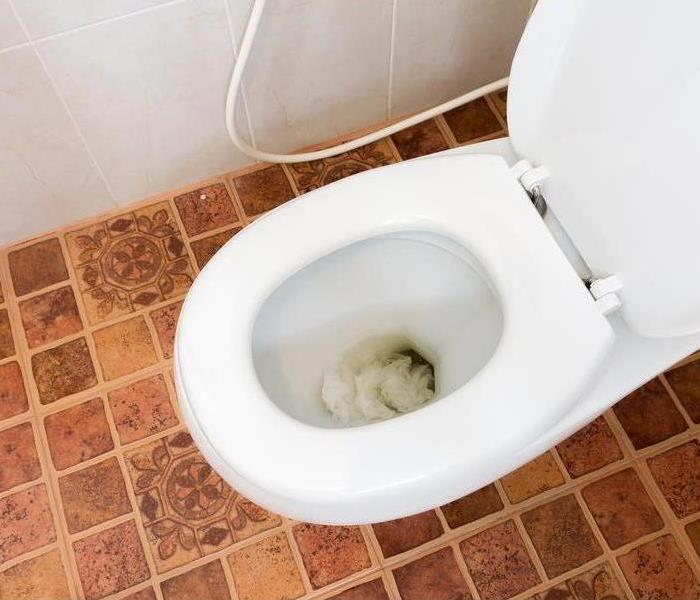 Toilets overflow causing serious issues and water damages
Toilets overflow causing serious issues and water damages
If your toilet overflows, it doesn't mean that you're going to have to buy a new one. There are ways to deal with this common plumbing problem, and they're easier than you might think.
Shut off the Water
At the first sign of water damage, shut off the water supply to the toilet. Turn off the main water valve that feeds your home, which can be found in your basement or crawl space. Shut off the water supply to the toilet at either its valve or tank, depending on which you find more convenient (if there's a valve for both).
If there's no way to shut off your toilet's water tank (or if turning it feels too dangerous), turn off a faucet nearby and fill up as many buckets as you need with clean water. Now use these for flushing purposes only. If possible, have someone do this so that both of you don't have to deal with any messes from overflowing toilets.
Turn off the feed valve to the overflow pipe
An overflow is one of the more common plumbing problems that you’re likely to encounter. While it may seem like a serious issue, you can usually handle a toilet overflow quickly and easily.
Once the water is turned off, next you want to turn off the water supply to the toilet. Turn off the feed valve to the overflow pipe and use a bucket or plunger to suck up all the water from the bowl, then empty it when you're done. This will help prevent water from overflowing into the floor causing more water damage.
Use towels on the floor to absorb water and prevent damage
If there is water puddles on the floor use old towels to absorb water and prevent damage. Use enough towels to soak up the excess water and protect your flooring. Don't leave the wet towels on the floor as it could cause more problems down the road. Keep the area free of debris to prevent slip and fall.
If you have a bathroom with tile floors, place the towels on top of each other, overlapping them slightly along their edges so that there are still gaps between them where water can drain through. Put them in a pattern around the overflow hole in your toilet bowl so that fluids that seep through can be caught by one of the layers of towels. This will help keep your floors dry even if there is still more water coming out of your pipes after you flush.
Bucket or plunger to suck up all the water from the bowl
Once the water is off the floor, use a bucket or plunger to suck up all the water from the bowl. This is probably your best option if you don't want to deal with a full toilet. Remove all the water from the bowl incase the toilet has to be replaced.
If your toilet has been overused or if there's been an increase in household traffic (such as company staying over), then try flushing less often until things return to normal. This will help prevent future overflows due to excessive use of your water supply system's capacity during peak times.
Use a Professional
If you're unsure about the problem, or if it seems like a more serious issue than your average clog, consider calling a plumber. A plumber can visit your home and assess the situation to determine whether it's something you can fix yourself (and what caused it in the first place). If so, they'll be able to teach you how to prevent future problems with your toilet.
When you are in need of a restoration company for your water damage, give SERVPRO of Oakville/Mehlville a call at the first sign of damage.
Office Fire Safety 101: Tips for Fire Prevention in the Workplace
1/10/2023 (Permalink)
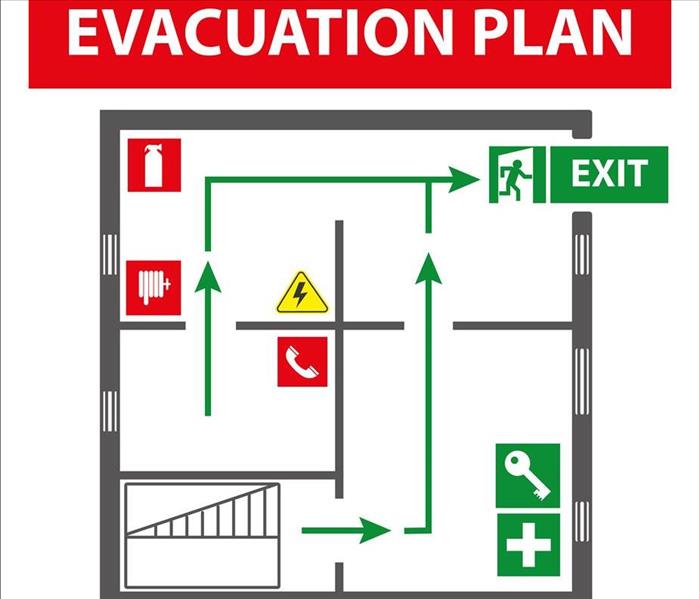 It's always a good idea to have an evacuation plan in place for your workplace.
It's always a good idea to have an evacuation plan in place for your workplace.
Tips for Fire Prevention in the Workplace
Fire safety is an important aspect of any business, especially one that deals with large amounts of electrical equipment. However, many firms do not think about fire protection until they have experienced a dangerous situation. By following these tips you can prevent fires and limit damage to your business property if one ever occurs.
Designate a point of contact for emergencies
The most important thing to do is designate a point of contact for all emergencies. This can be anyone in the office, but it's best if they're someone who is familiar with the building and/or has experience dealing with fire safety issues. If you have multiple floors in your office building, try to have someone designated on each floor as well.
Ensure exits are always clear
You should ensure that all exit doors open in the direction of travel, and that they are not blocked by furniture or other items. Exit signs should be clearly visible and illuminated as well. When it comes to ensuring safety in your workplace, there are many things you can do to help keep everyone safe.
Don’t panic when evacuating
If a fire is burning, how do you get out of the building? It's always a good idea to have an evacuation plan in place for your workplace. Be sure everyone knows where the exits are and how far away they are from their workstations. If there's no way out, it may be necessary to break a window so people can escape. But don't assume that just because there's smoke coming into your office that it won't spread quickly; that smoke could actually be blocking another exit route and preventing it from being used by all who need it!
Another important thing to remember: Do not use elevators during an evacuation—they take too long and could become stuck between floors or even stop working altogether due to electrical problems or lack of power (as well as possibly trapping people inside). Instead, take stairs if possible—it'll help speed up the process by keeping people moving at the same rate instead of waiting on an elevator line while they're trying to get back down safely without hurting themselves in any way possible."
Count heads and call 911 once evacuated.
Once you've safely evacuated the premises and called 911, it's important to give the dispatcher all of the information they need. This includes:
- Your name, address, and telephone number.
- The nature of the emergency (for example, fire).
- The location of the fire (house number, street name).
- Any injuries or casualties involved in this incident.
If possible, provide details about how far away from your property any injured people are located so that firefighters can get there as soon as possible!
Keep important documents and other valuables in a safe place.
If you have valuable documents that you don't want damaged during a fire or water damage, store them in a fireproof safe. You can either purchase one of your own or ask your employer if they have one available for use.
Always keep copies of your most important documents on hand. This way if the originals are lost or destroyed during an emergency, you will still have access to them through the copies.
Make sure everyone who works at the office knows where these items are kept so they can be accessed quickly in case of an emergency situation requiring evacuation or relocation indoors (which happens more often than people think).
A fire safety plan is crucial.
Fire safety is a priority for everyone. It's up to you and your employees to ensure that your workplace has the necessary fire protection measures in place, and that those measures are working properly. Fire prevention is everyone’s responsibility, so it's important that you take steps to prevent fires from starting and spreading in your business.
Keep an eye out for any potential fire hazards in your building or office space (e.g., faulty wiring or overloaded electrical outlets). If you notice anything suspicious or out of place, alert someone immediately so they can take action before disaster strikes!
It’s clear that there are many things you can do to keep your workplace prepared for a fire. As we mentioned at the start of this post, fires can be extremely dangerous and destructive. But with proper planning and maintenance, you can minimize the risk of those events occurring in your workplace.
Mold and Appliances
12/14/2022 (Permalink)
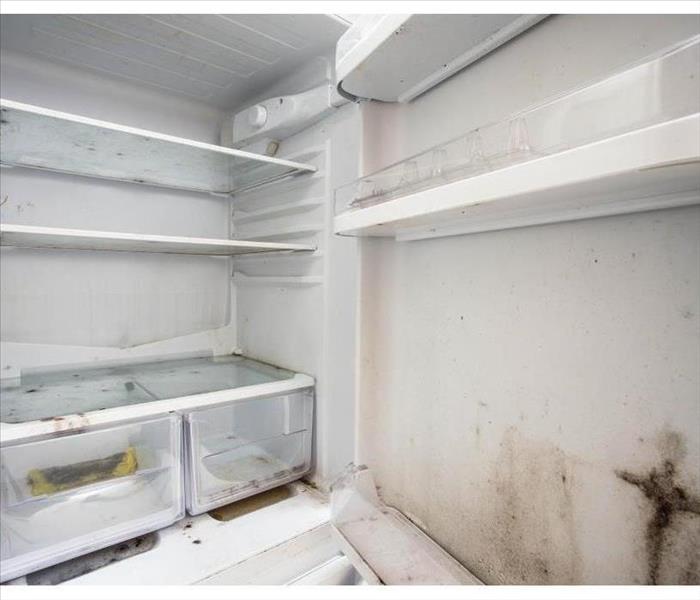 Mold growth in appliances is a serious issue and should be taken very seriously.
Mold growth in appliances is a serious issue and should be taken very seriously.
Mold, the fungus that grows on damp surfaces in your home, can be difficult to remove. It thrives in warm, humid environments and spreads without proper ventilation. The most common places for mold to grow are in bathrooms and kitchens. Appliances are another culprit for carrying mold into your kitchen—especially when they're not cleaned regularly or have been exposed to moisture from flooding or water damage. To prevent these appliances from becoming prime breeding grounds for mold, it's important to clean them regularly with a disinfectant spray or other method of sanitization.
Washing Machine
Mold is a common problem in washing machines. If you don't keep your washer clean, mold will grow on the rubber gasket and other parts of your machine, causing it to smell bad. Mold can also lead to your clothes smelling bad if they come in contact with it!
To keep mold from growing inside of your washing machine:
- Use vinegar to help clean out any buildup around the rim where water collects when you run a load of laundry.
- Look into replacing the seal around the door of your washer if it looks cracked or torn (this is especially important when trying to prevent mold growth).
Refrigerator
Mold growth in refrigerators is common. In fact, it's so common that you may not even be aware of the mold growing on your refrigerator until it's too late. Like most mold growth in homes, it can be prevented by keeping a clean refrigerator and storing food properly. Mold also thrives in high humidity environments. To prevent mold from forming on your fridge, follow these steps:
- Clean out your fridge regularly! If you don't remember if something was inside the last time you cleaned it out (and who does?), put an empty box with a note inside for future reference.
- Don't store foods at room temperature for long periods of time; instead, keep them chilled in the fridge or freezer as needed to preserve freshness and quality.
Freezer
The freezer is the best place to keep food, as it's the coldest spot in your refrigerator. But before you start stocking up on frozen foods, make sure that your freezer is clean and hasn't been used to store anything other than ice cubes or frozen foods. You should also keep an eye out for excess frost—if there’s too much ice buildup in your freezer and/or if it's starting to look like a snow globe inside, you need to defrost it!
Dehumidification
Dehumidification is a way of removing moisture from the air. You can use a dehumidifier to do it, but you can also do it with other devices. A dehumidifier is an appliance that removes moisture from the air in your home and helps prevent mold growth. It's helpful for drying out wet carpets, floors, walls and furniture after flooding or leaks occur. These appliances are available in different sizes and models for small or large rooms.
Dehumidifiers also come with settings for optimal humidity levels for different temperatures, so you'll always stay comfortable at home regardless of how much time you spend indoors during winter months when heating costs are higher than summer ones when cooling costs are more expensive than average year-round temperatures require less energy usage overall.
Act Quickly
Mold growth in appliances is a serious issue and should be taken very seriously. If so, it's important to act quickly before the problem gets out of hand and leads to major property damage in your Lemay, MO home.
Mold can be expensive and time-consuming, and that’s why SERVPRO of Oakville/ Mehlville is here to help! We want everyone who uses our services to know that they can trust us with any appliance-related mold issues whether they're small or large.
5 Steps To Prepare Your Business for the Next Winter Storm
12/1/2022 (Permalink)
 Create a plan for regularly checking and clearing out gutters.
Create a plan for regularly checking and clearing out gutters.
Follow These Five Steps
If you have a business in Bella Villa, MO, winterizing your commercial property for the colder months ahead should be a top priority once temperatures start to drop. Failing to properly protect your building can have high costs. A winter storm often brings heavy winds and snowfall that can do significant damage. To reduce the chances that you will need to hire disaster restoration professionals for the next spring thaw, follow these five steps.
1. Assess the Risks
Take a look around the property. Ask yourself: What kinds of risks could happen? For example, consider employee injuries and frozen pipes. Make any repairs that might be susceptible to structural stress or other types of storm damage.
2. Assign Responsibility
Another major part of preparing for a winter storm includes assigning roles and responsibilities to qualified staff and professionals. Figure out who is going to make the parking lot safe when it ices over. Additionally, if repairs are complex, decide which company you will call for assistance.
3. Plan for Each Threat
After identifying the wintertime risks your company might face, work with employees to create an action plan for each threat. If, for example, you have concerns about ice dams forming, create a plan for regularly checking and clearing out gutters.
4. Remember To Be Comprehensive
When you protect your building against storm damage, do not forget to be thorough. There are many potential locations for damage to occur. In addition to the roof, plumbing and HVAC systems should be other top concerns.
5. Prepare Your People
Preparing your property is important, but it is only half of the equation. The other half you have to remember includes the people who run the organization. Before the snow starts coming down, make sure you train everyone on any applicable procedures and have a way to communicate updates.
Running a business somewhere with harsh winters comes with unique challenges. Planning ahead can make things easier. You can help your company prepare for the next winter storm by following these steps.
What To Do If a Water Heater Leaks?
11/14/2022 (Permalink)
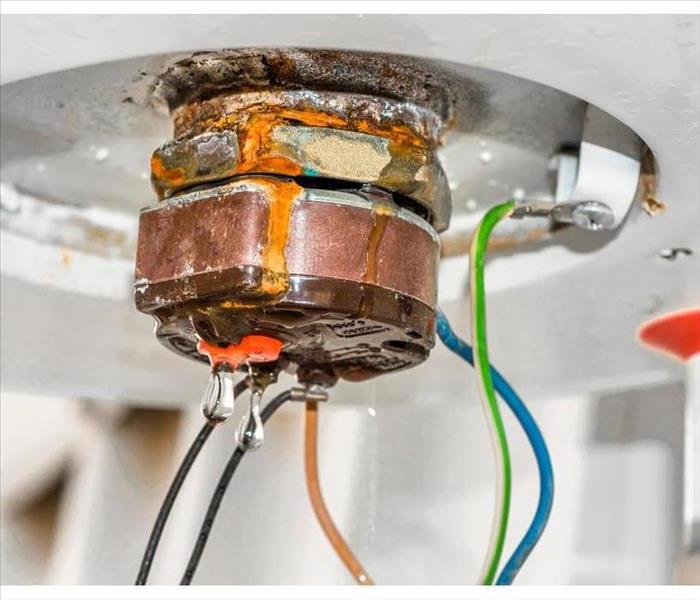 It's critical to understand what to do if your water heater leaks or malfunctions.
It's critical to understand what to do if your water heater leaks or malfunctions.
5 Steps to Take After your Water Heater Leaks
Water heaters are an essential part of your home. They heat water for showers and laundry, help keep you warm in the winter, and even provide hot water for cooking. However, just like any piece of equipment that runs 24/7, it's important to know what to do if your water heater leaks or breaks down. Here are some tips on how to handle a leaky or broken water heater.
First, shut off the water.
Shut off the water at the main valve. If you have a pressure tank, turn it to “off.” Or if there’s no pressure tank and your home has a well, go outside and shut off its valve as well. If you can't find your main valve or don't know how to turn it off, contact an expert; they will probably be able to help you locate it and guide you through this process safely.
Second, turn off the power to your water heater.
The next step in fixing a leaky water heater is to shut it down. This can be done by turning off the main power switch or circuit breaker, or by opening a cover plate over your water heater and flipping a lever on its electrical box so that you can't turn it back on again until you reset it. You'll also need to ensure that there's no gas running into your unit; if there is, turn off the supply valve for the gas line right away!
If there's no way of turning off both valves—either because they're inaccessible or because one is flooded—turning off power may be your only option for stopping leaks in progress.
Third, empty out your water heater.
The easiest way to drain water from a water heater is to open the drain valve on the bottom of the tank. If you don't see a valve, look for a small hole near the bottom. It should be labeled "drain."
To open the drain valve, use an adjustable wrench to turn it counterclockwise until it clicks into place. Then run your hand along the bottom of the tank to make sure there are no obstructions (like debris) in the way of allowing water to flow freely out of your tank.
The other option is to remove some of the water yourself using a bucket or container—but this isn't recommended unless you have a lot of experience with hot water heaters and know what you're doing.
Fourth, clean the area to prevent mold and mildew.
Once you've removed your items from the area, clean the area. This can help prevent mold growth and other unwanted things from developing if they were to encounter the water in your basement.
Fifth, repair your water heater or replace it.
If any part of your water heater has been damaged or if there is too much rust on it, it may be time for a replacement. If this is the case, contact a professional plumber who can perform repairs and/or install a new one in its place. Repairing or replacing your water heater will prevent that unit from causing any more damage.
We hope this article has helped you figure out what to do if your water heater is leaking and what the next steps are. If you have any questions, please feel free to contact us!
Preparing for the Claims Process and Adjuster Visit After a Commercial Fire
11/1/2022 (Permalink)
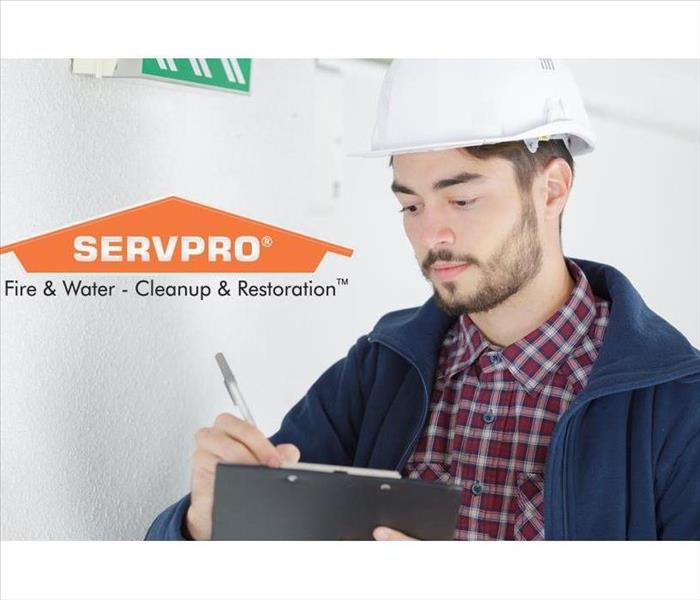 The Insurance Adjuster works closely with our team from start to finish.
The Insurance Adjuster works closely with our team from start to finish.
Preparing for the Claims Process and Adjuster Visit After a Commercial Fire
Depending on the extent of the damage, most business owners will choose to file a fire claim after experiencing such a disaster. Unfortunately, making a claim on your policy can create a lot of stress and anxiety because it is a process that most people are not familiar with. Therefore, to help you prepare for the claims process and the visit from the insurance adjuster, follow these four steps.
- Call your insurer
- Mitigate further loss
- Gather and maintain records
- Document loss
Call Your Insurer
Before you can even consider getting the ball rolling on fire restoration, you need to call your insurer and explain what happened. During this phone call, they will probably ask a few probing questions about the fire and the extent of the damage, then they will tell you that they are sending someone out to assess the property and damage.
Mitigate Further Loss
Before touching anything in your property, make sure you clear it with your insurer first, so that you do not jeopardize your fire claim. Most insurance companies expect property owners to take the necessary steps to protect their facility from further property loss. Therefore, they will probably recommend using a fire mitigation company in Bella Villa, MO. Any company you work with may offer board-up or tarping services to protect your building.
Gather and Maintain Records
Next, regardless of the level of fire damage, you will need to gather any relevant records of the damaged property. Also, for any work that you need to complete before the adjuster approves your claim, make sure you keep all receipts and paperwork.
Document Loss
Last, take plenty of photographs of the damaged property. If you have any pictures or documentation of when the items were first purchased, then it may be useful to the adjuster to see those as well. Organize all of the photos and paperwork so that it makes sense.
The process for submitting a fire claim can seem overwhelming, but as with any other bureaucratic process, claims are built around a series of predictable steps. Therefore, when preparing for your claim, follow the steps above and you should be just fine.
Fire Regulations for Businesses
10/13/2022 (Permalink)
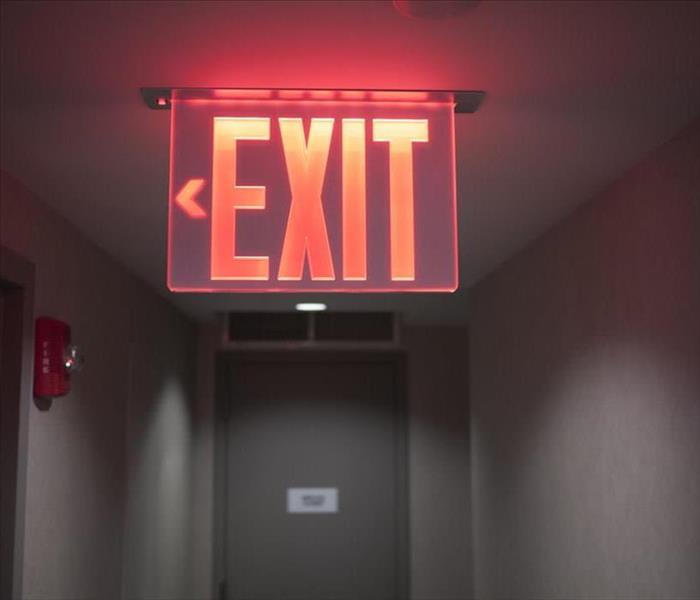 EXIT signs can help save lives.
EXIT signs can help save lives.
What Are Common Commercial Fire Regulations?
If you own a business and have employees, there are many regulations that you need to follow. As an employer, you have a responsibility to provide a safe environment for your staff. Fire safety is one of those things that can't be overlooked because it's important for both your employees and guests. This blog post will go over the laws regarding fire safety in businesses, as well as how to make sure they're being followed properly.
Exits
There are three types of exits:
Exit passageways (must be unobstructed, clearly marked, and easy to open from inside and outside)
Exit discharge areas (must be a minimum of 3 feet wide and 36 inches high)
Exits (must be a minimum of 5 feet long, 10 feet apart, and must have an opening for passage in both directions)
Callbox
Call boxes are another way to contact the fire department. They are usually located near the front door so that anyone can use them when they need help. Call boxes should have a lighted sign that says “call 911” and any other type of emergency number (depending on your location). The call box should also have a lock on it so people can't get in if they don't need to.
Sprinklers
Sprinklers are an important safety measure for any business. They can be installed in any type of building, no matter the size or shape, and they're a great way to prevent fires from spreading. If you're looking for a way to protect your property, consider installing sprinklers in your building today!
Smoke alarms
Fire alarms and smoke detectors are required in all businesses. Smoke alarms should be installed in every sleeping room, hallway, and near all cooking appliances. These devices should also be tested monthly to ensure that they are functioning correctly. Check the manufacturer's instructions for proper testing procedures.
- Smoke alarm replacement: Smoke alarm batteries should be replaced at least once per year. You may need to replace your smoke alarm if it has been 10 years since you last replaced the battery or device (the date of manufacture will be on the back label). If you have never changed the battery or device, this would be a good time to do so now before putting them into service again!
- Carbon monoxide alarms: Carbon monoxide gas is colorless, odorless, and tasteless so it can't easily detected by sight or smell alone; however there are carbon monoxide alarms available specifically designed for homes that will alert occupants when dangerous levels of CO exist inside their home due to malfunctioning furnaces/heaters, etc.
Fire extinguishers
You should be familiar with how to use a fire extinguisher and its classifications.
First, if a fire breaks out in your business, you should know how to use the closest fire extinguisher in an emergency.
Second, you should verify that your employees are aware of what type of fire extinguishers are available in each room or area of the building.
Finally, after using an extinguisher on a small blaze, put it back into its designated spot for storage so that it doesn't get damaged or used by mistake later on (if there's another major blaze). In fact, check all updated regulations about which types need to be replaced after each use; some only last for about six months before losing effectiveness! It's important to keep track here because those regulations vary by state-and even upstate vs downstate can differ from one another!
Emergency escape plan
- Create an emergency escape plan for every building, including all exits, fire escapes, and other routes of escape.
- List the number of employees inside the building during normal operation and any occupants who may be there at other times, such as contractors or guests. This helps you decide how many people need to evacuate in case of fire or another emergency.
- In addition to listing your employees, also include a list of those who are unable to evacuate due to age or physical limitations. Make sure they have evacuation assistance plans in place so they can get out safely if needed.
Hazardous material safety plan
Hazardous materials are dangerous. You need to have a plan in place to deal with them and make sure they're stored, transported, and disposed of safely. To do this, you'll need training and certification for staff who work with hazardous materials. Staff must be trained on how to recognize the hazards associated with each type of chemical used at their workplace and how those chemicals should be handled during normal operations.
Hazardous substances can include corrosive liquids like acids or bases; combustible liquids such as gasoline; flammable liquids like paint solvents; poisonous gas such as chlorine gas; oxidizing material such as perchloric acid; radiation-producing sources (for example x-ray films); medical waste that may contain infectious agents.
Regulations are often confusing, but when it comes to fire safety, they're there for a reason.
Fire regulations can be confusing, but they're there for a reason. Your local fire department can help you understand how to comply with the regulations and stay safe.
To find out more about fire safety rules for businesses, contact the fire department in your area or visit their website.
The bottom line is that it's important to take fire safety seriously because if a fire starts in your business, the consequences can be catastrophic. As the owner or manager of a company in Oakville, MO, you have a responsibility to make sure that your employees are safe at all times—and part of that job is ensuring they know what to do when there's an emergency.
What To Do About Sewage Backup
10/1/2022 (Permalink)
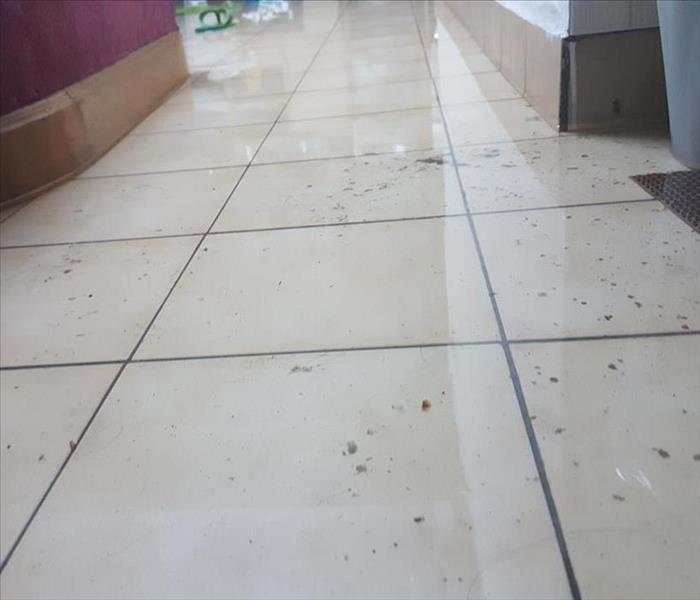 If you have a sewage backup, proceed with caution.
If you have a sewage backup, proceed with caution.
What To Do About Sewage Backup
A flooded basement is a homeowner’s nightmare, particularly when it’s a sewage backup resulting from storms and heavy rains. Heavy rainfall, especially over a prolonged period, can place a burden on public sewage systems that have a limited capacity. Once the rainwater exceeds this capacity, excess water may begin backing up and overflowing into your sewer line. This can happen quickly and unexpectedly in White House, MO, as well as most areas of the U.S. When it does, you should take the following three steps.
1. Evaluate the Situation
The first thing you should do after you discover a flooded basement is evaluate the situation. If you have a sewage backup, proceed with caution. Sewage spills that contain infectious waste can create health hazards. Keep humans and pets away from the flooded area until you know what you’re dealing with.
2. Put Safety First
Disconnect all electrical items, including furnaces, before entering a flooded area. It’s a good idea to cut off both the electric and water mains for safety and to stop any water flow. Don't use any appliances or fixtures that utilize water, either, such as showers or washing machines. If a burst pipe played a role in the backup, you don't want to add any additional water or pressure to the situation.
3. Take Quick Action
Take action quickly. Remove any items that have not been affected by the backup to minimize damage. If possible and weather permits, open all windows. Remove as much excess water as you can and run dehumidifiers if you have them. The goal is to dry out the wet area within 24-48 hours to reduce the risk of mold forming. Remember to wear safety clothing such as rubber boots, gloves, and face masks when working in the affected area.
If you have a flooded basement, you should contact a professional cleaning and restoration service. If you have minimum flooding, you might be able to clean it yourself, but it’s still best to consult a professional, particularly when dealing with basement sewage.
5 Essential Storm Preparation Tips
9/27/2022 (Permalink)
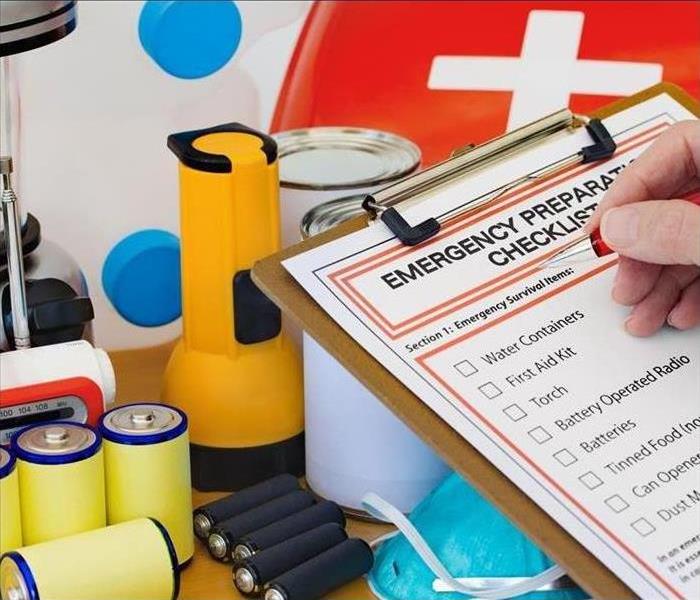 An emergency response kit can help keep your household safe during a storm
An emergency response kit can help keep your household safe during a storm
Protect Your Home And Family From Severe Weather
Preparation is key when it comes to protecting your home in White House, MO, from severe weather, floodwater and other types of water damage. Planning ahead and making sure you're prepared before a storm hits is key to reducing flood damage and keeping your family safe. Follow the tips below to help protect your home and family from severe weather.
1. Create an Emergency Preparedness Plan.
Craft a clear emergency response plan for your family that is easy to follow. Make sure everyone knows where to go and what to do in the case of a severe storm. Make time to regularly discuss and practice this plan, especially if your local weather channel predicts an incoming storm.
2. Build an Emergency Supply Kit.
An emergency response kit can help keep your household safe during a storm. Suggested items to stock include, but are not limited to, batteries, bandages, gauze, a flashlight and a battery-powered radio.
3. Pay Attention to Local Emergency Alerts.
The Emergency Alert System (EAS) can provide reliable, real-time updates regarding the storm. Make sure everyone in your household signs up for this system so that you can stay updated on new developments.
4. Protect and Waterproof Valuable Items.
Any valuable items that are unlikely to survive a flooded building need to be sealed in waterproof containers and relocated to a high shelf that's at least one foot above the floodwater level. This includes important documents, electronic devices and other important possessions that are susceptible to water damage.
5. Trim Back Overgrown Tree Branches.
Severe winds can quickly transform overgrown tree branches into dangerous projectiles. You can help prevent tree limbs from flying in through your windows by trimming back any branches that are growing too close to your property.
Rising floodwater, dangerously high winds and heavy rains can all inflict devastating damage on your property if you aren't prepared. Contact flood remediation experts if your home has suffered damage from a recent storm or flood.
Which Air Purifiers Filter Out Mold Spores?
9/17/2022 (Permalink)
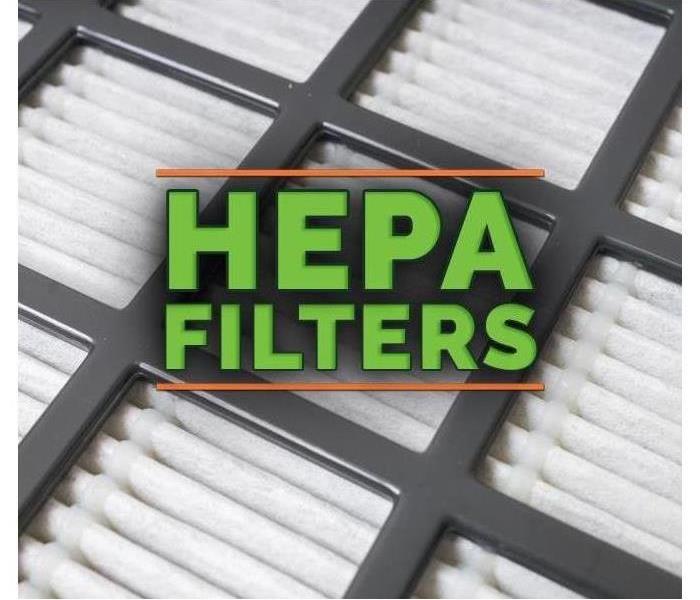 A HEPA filter meets a standard for filtering airborne particulates set by the U.S
A HEPA filter meets a standard for filtering airborne particulates set by the U.S
Which Air Cleaners Remove Mold Spores?
Air purifiers are helpful for lowering mold spore concentrations in interior air. High-efficiency particulate air filtration technology is not capable of eliminating spores or stopping mold from spreading through a residence located in Mehlville, MO. An air purifier is most useful for reducing the amount of spores that remain following mold remediation.HEPA Air Purifiers
A HEPA filter meets a standard for filtering airborne particulates set by the U.S. Department of Energy. This standard includes all of the following specifications:
- Removes at least 99.97% of airborne particles
- Captures particles 0.3 microns in diameter and larger
- Meets retention requirements for a HEPA class
There are several classes of HEPA filters, including three classes -- E, H and U. Each class has three subcategories. E class filters have the lowest average retention rate, while U filters have the highest rates of averaged and spot retention.
Carbon Air Filtration
A carbon air filter is used primarily to remove gases. This makes this type of filter useful for eliminating microbial volatile organic compounds released during the metabolic cycle of mold. Carbon filters are effective at capturing spores and mVOCs, making this style of purifier useful for homes undergoing mold remediation.
Ionic or Electrostatic Filters
Ionic and electrostatic filters both function by causing particles to drop down to surfaces where they can be cleaned. A HEPA-rated vacuum can be used to get rid of mold spores that drop down out of the air during operation of these types of charged filters. Technically, both of these filters are ionic and may contribute unwanted ozone to indoor air.
Any air purifier will be of limited use prior to taking measures to resolve a mold problem at a household in Mehlville, MO. HEPA, carbon, or ionic air filtration equipment will be most effective when this air quality technology is deployed during the later stages of mold remediation and cleanup.
At What Point During Restoration Can Employees Come Back to Work?
9/1/2022 (Permalink)
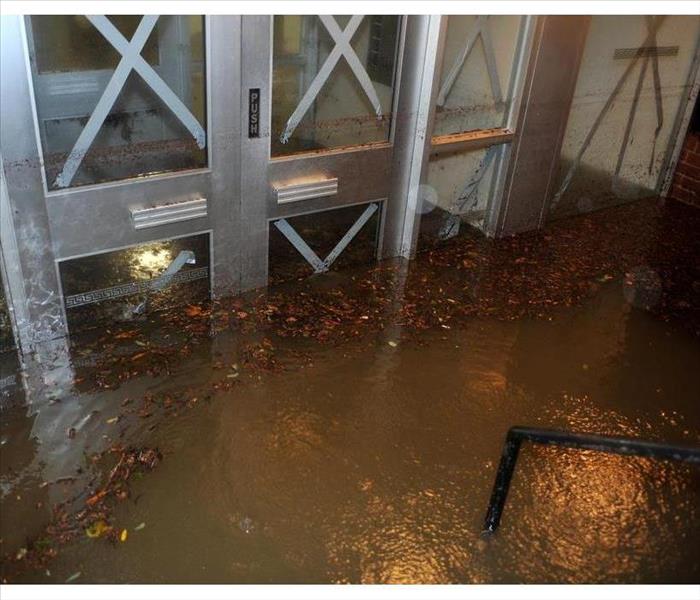 Flood damage business in White House, MO.
Flood damage business in White House, MO.
When Can Employees Return to Work After a Restoration?
Your business has survived a flood in White House, MO and now you’re ready to get back to work. However, the restoration crew is still on-site, combating black water, bacteria, and structural dangers. So when is it safe to bring your employees back? To help you make that determination, here are the three stages of the restoration process and what you need to know:
1. The Removal Stage
Floodwaters can leave behind standing water that quickly creates mold and bacteria. If this is combined with sewer backup, it is known as “black water.” This is generally the top priority for a restoration company. While the professionals are working to remove it and complete this part of the cleanup, no one is safe to come back to work in the building.
2. The Demolition and Disinfection Phase
One of the things a flood cleanup crew will do for your business is work with you to figure out what can be saved and what needs to be demolished. Certain porous items such as carpeting and drywall will need to be disinfected and in many cases removed, as they contain harmful bacteria. During this phase, it is also not safe for employees to return to the building.
3. The Rebuilding Stage
After floodwater has been removed and the business’s walls and carpeting have been demolished or disinfected, it is usually safe for employees to come back to work, even while some rebuilding is still taking place. Installing air filtration devices is a smart precaution to clean the air. It will also set the minds of staff at ease while the restoration company wraps up the job.
Black water and other safety concerns make it necessary to be cautious about allowing employees back into a business after a flood. By knowing what step of the cleanup process the restoration crew is performing, you can make a safe determination and get your company back on track quickly.
3 Things To Do if Mold is in Your Home
8/20/2022 (Permalink)
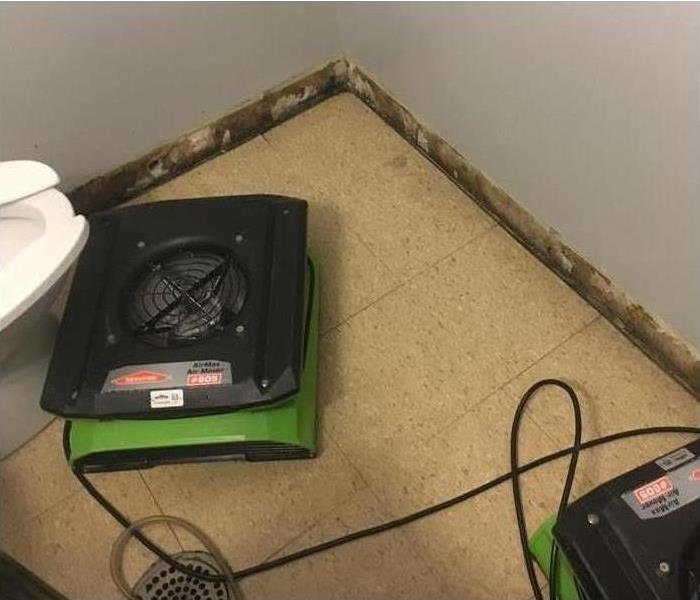 Mold damage in Bella Villa, MO
Mold damage in Bella Villa, MO
Mold Development
After water damage affects your Bella Villa, MO, home, there’s a chance you could also develop problems with mold. Fortunately, there are a few things you can do if mold is discovered. Here are three things you may want to consider.
1. Call a Professional
One of the first steps to consider taking is contacting a local mold damage remediation service. These professionals have the training and tools needed to locate any mold, assess the damage, contain the space, and clean the area. Professionals will often use plastic sheeting to separate the area in which the mold is growing from other areas of the home to prevent spreading. While working in the contained area they will also wear protective gear such as gloves, masks, clothing covers, and shoe coverings.
2. Look for Leaks
Another step for mold prevention is to look for any leaks, or other sources of water damage, any time you suspect mold may be present. These spaces can be around plumbing, window frames, under the roof, or in basement areas when moisture condensation may occur. Water can soak in and create a damp environment which is hospitable for mold growth. Finding these areas and making repairs quickly can help prevent mold from growing in the first place.
3. Repair Damage Quickly.
It’s important to make repairs to any damage you do find in your home as quickly as possible. This can not only help prevent mold growth but may also help prevent other related damage problems such as warped wood. Additionally, the longer water is left, the more time mold spores have to grow and spread.
Any time water damage is present there is also a chance mold could appear. This is why it’s important to contact a professional for help. It’s also a good idea to look for any leaks that could be causing the damage, and make repairs quickly.
Steps for Basement Flood Remediation
8/15/2022 (Permalink)
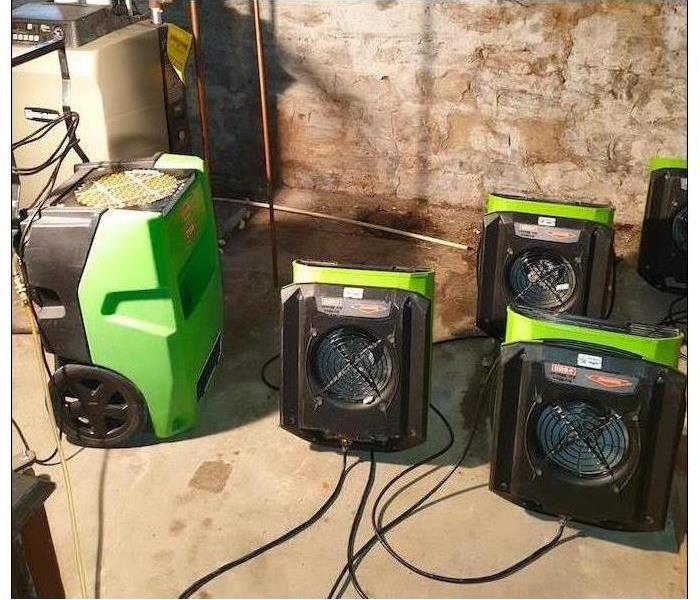 Flood restoration specialists have the equipment and expertise needed to fix a flooded basement.
Flood restoration specialists have the equipment and expertise needed to fix a flooded basement.
How to Clean Up a Basement Flood
There are several things that can cause a basement flood. A broken pipe, leaking appliance, sewer backup, or heavy storm can all result in standing water in the lowest level of your home in White House, MO. There are several steps you should take when you discover such a problem.
1. Call the Professionals
You should never wade into standing water on your own. Flood restoration specialists have the equipment and expertise needed to fix a flooded basement. Once you make the initial call, they can arrive within hours to handle every step of the process:
- Assessment
- Extraction
- Drying
- Cleaning
- Restoration
Take quick action to get the mitigation procedures started as soon as possible. A fast response can not only prevent secondary damage from the basement flood but also makes your home livable again in a shorter amount of time.
2. Review Your Insurance Policies
Your homeowner's insurance coverage may be able to save you a lot of the out-of-pocket expenses associated with flood remediation. Call your provider as soon as you can. The company will send an adjuster to survey the damage and come up with an estimate of how much your policy covers. Be sure to have the restoration company's detailed assessment on hand to support your claim.
3. Research Prevention
Once the flood damage in your home has been mitigated, it makes sense to look for ways to prevent future mishaps. Talk to the technicians about ways to keep water out of your basement, and invest in a reliable sump pump that can quickly get rid of any water that does enter. Ask neighbors with similar floor plans about the steps they have taken to make their basements more resistant to flooding. Your insurance agent may also be able to provide tips on upgrades you can make.
A basement flood can make a big mess, but quick remediation is the key to keeping it from getting out of hand. Act quickly to get the service and support you need.
How to Use a Fire Extinguisher
8/1/2022 (Permalink)
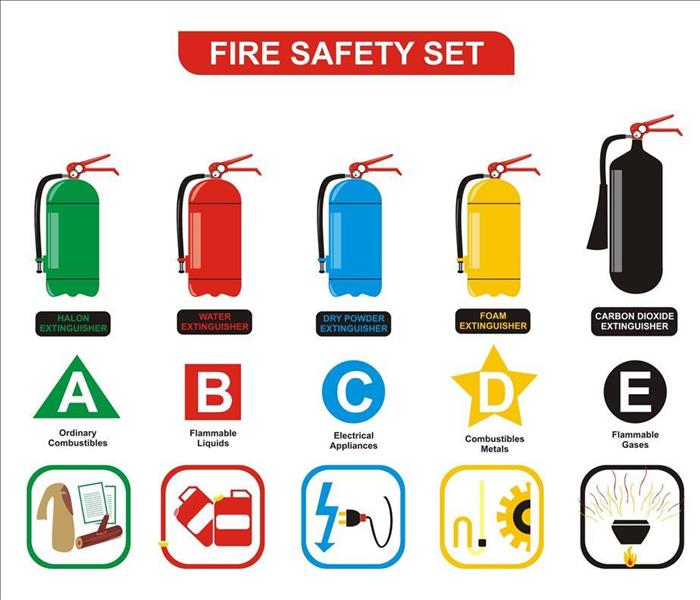 Not all fire extinguishers are created equally.
Not all fire extinguishers are created equally.
While nobody wants to think about a kitchen fire or another type of fire in the home, it is important to protect your space with a fire extinguisher. Use this guide to help you.
Choosing the Right Extinguisher
The first step in fighting fire damage is ensuring you have the proper tools. Not all fire extinguishers are created equally.
Class A: Use for solid combustibles such as cloth or wood.
Class B: Use for gases and flammable liquids.
Class C: Use for electrical fires.
Class D: Use for flammable metal.
Class K: Use for grease and oil fires.
When fighting a fire, never use water on electrical fires or oil or grease fires. Water on an electrical fire can cause electrocution. When you put water on a grease fire, it can cause the flames to shoot out and spread.
Where to Store It
At a minimum, have one fire extinguisher on every level of your home. This is especially important in places where fires are most likely to break out, such as the kitchen or garage. Avoid placing your extinguishers near heating appliances or drapes, which can make it harder to reach them if a fire does break out. Instead, mount them near the doors you would use as an escape route during a fire. Make sure they are high enough that small children and pets can't reach them.
Using It Correctly
Before you begin using your extinguisher, ensure it will do the job. If the fire is taller than you are, exit the room and call 911. Only if it is pressurized, shorter than you and the right type of extinguisher for your fire should you use it. To extinguish a fire, pull the pin and keep the nozzle aimed at the bottom of the flames so you can smother them. Squeeze the trigger and move the nozzle from one side to another, pointing at the base the entire time.
A fire extinguisher can help you to avoid severe fire damage in Lemay, MO. If you purchase a disposable one, remember to replace it when necessary.
What Types of Water Damage Are Covered By Your Homeowners Insurance?
7/28/2022 (Permalink)
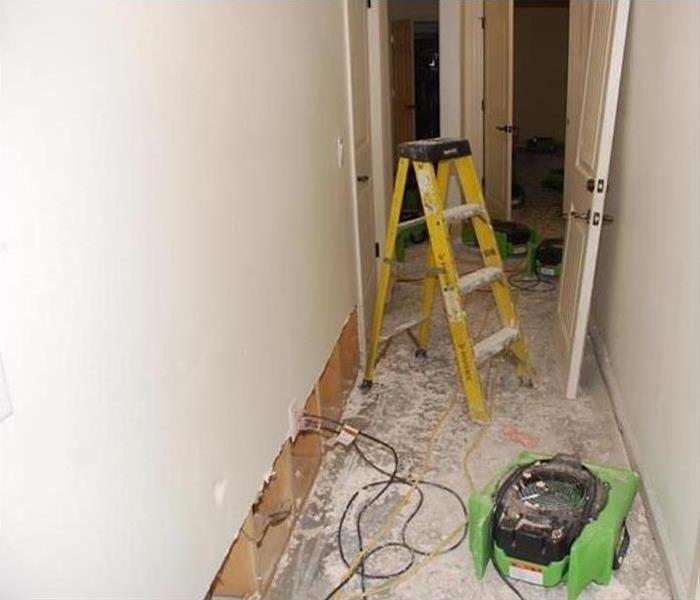 Water damage in a home in Mehlville, MO.
Water damage in a home in Mehlville, MO.
Which Water Damage Types Are Covered by Your Homeowners Insurance?
If a flood has occurred in your Mehlville, MO, home as the result of a broken pipe or appliance, then you will need to file an insurance claim to cover repairs. Because these can be costly, you may be wondering exactly what is included in your insurance policy. The following are a few types of damage that you might be dealing with.
1. Initial Damage
Initial damage occurs immediately after the pipe or appliance is broken, as soon as the water enters the home. This can include damage to a variety of items, such as electronics, furniture or paper items. This is almost always included in your insurance coverage, as long as the cause was not preventable.
2. Secondary Damage
Secondary damage that occurs due to the flood in your home is often included as well, as long as mitigation and repairs were performed in a reasonable time. This can include structural damage such as rotting or warped wood as well as the growth of mold and mildew.
3. Gradual Damage
If the pipe has not broken suddenly and instead caused damage through a persistent leak, then this is considered gradual damage and will likely not be included in your insurance policy. Because it is expected that the homeowner will perform proper maintenance, if you have noticed a leak and not bothered to have it repaired or you have not done regular inspections, then the insurance company may determine you are at fault.
4. Broken Pipes
Even if it was sudden and accidental, the insurance company will usually not cover the costs to fix broken pipes. This is generally seen as normal maintenance for the home, so you, as the homeowner, will more than likely be responsible for any necessary repairs or replacements.
To prevent the damage from getting worse, excessive water should be removed from your home immediately. A water damage remediation company can help fix the source of the flood, make repairs on your home, and salvage many of your belongings. Luckily, your insurance will likely cover most of the costs.
3 Reasons To Inspect a Commercial Sprinkler System Before Using It
7/12/2022 (Permalink)
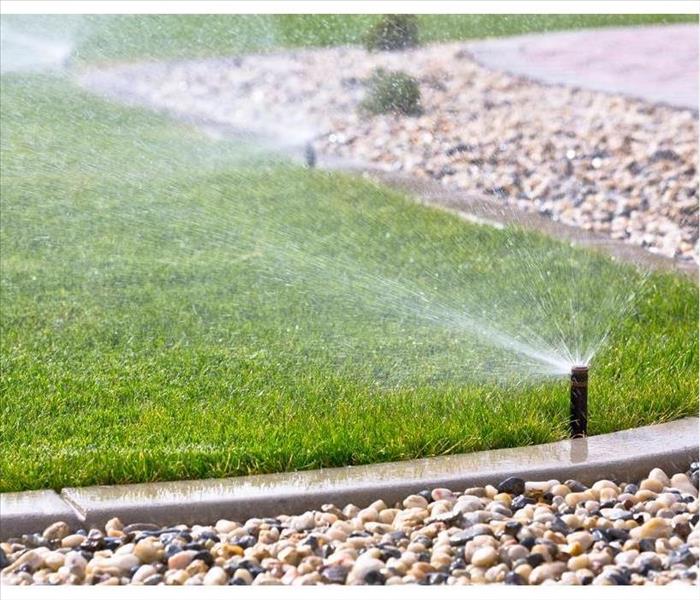 Performing irrigation maintenance at your Oakville, MO commercial property can be a wise investment.
Performing irrigation maintenance at your Oakville, MO commercial property can be a wise investment.
Commercial Sprinkler System Inspection
Using an automatic sprinkler at your Oakville, MO commercial property can beautify its landscaping and keep the trees and shrubbery there healthy. However, a lack of proper irrigation maintenance before and during the use of the system may result in inefficient watering, water waste, and flooding. Inspecting your system each year before turning it on can avoid these issues and a variety of others that can have a direct impact on your business.
1. Cost
If your sprinkler system is not working correctly and causing slow leaks or inefficient watering, this could cause you hundreds of dollars in water loss each year. When lines or head leaks go unnoticed, the water may never reach your property’s landscaping, which wastes it. Finding and repairing leaks may lower your company’s water bill and cut water waste.
2. Improved Landscaping Plant
Your company’s landscaping plants are likely a considerable investment for you. Not only do they beautify your property, but they can also attract the eye of prospective customers and make an impression upon anyone who visits your business. However, sprinkler flooding, low water pressure, and other problems can have a negative impact on your trees and shrubs, stunting their growth or causing them to look skimpy. Performing irrigation maintenance by having your sprinkler system inspected and floods drained by a commercial water damage and cleanup company can help improve your landscape plants.
3. Changes to Water Conservation Details
Even if your sprinkler system is working correctly, it may not be as efficient as it was the year before. Water conservation strategies can shift with each season, and keeping up with the changes can help you save money and ensure that your property is being watered in a way that prevents water waste.
Performing irrigation maintenance at your Oakville, MO commercial property can be a wise investment. From preventing water waste to protecting your landscaping plants, taking the time to perform these checks may provide you with peace of mind when it comes to maintaining your property as best you can.
5 Ways To Prevent Your Pipes From Freezing
7/2/2022 (Permalink)
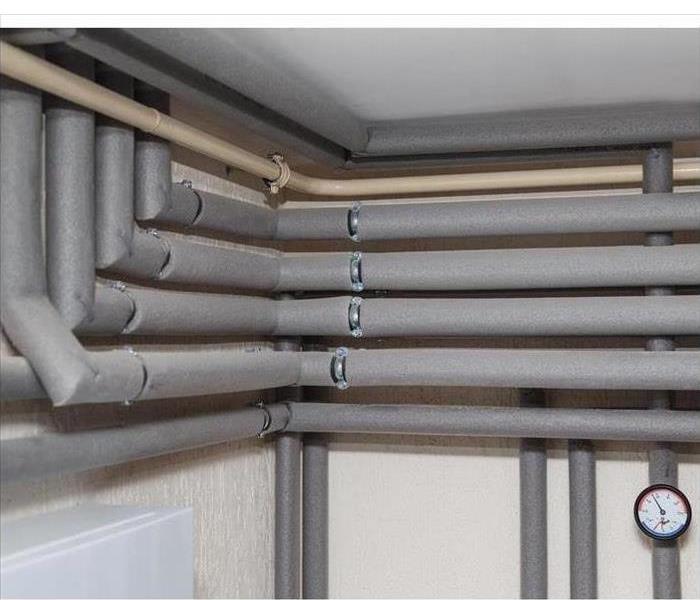 Any pipes located in colder areas of your house, such as the basement or attic, should get extra insulation.
Any pipes located in colder areas of your house, such as the basement or attic, should get extra insulation.
5 Ways To Avoid Your Pipes Freezing
Even if you live in a warm climate, you still have to worry about frozen pipes in your home. In fact, those who live closer to the Equator may be more vulnerable to this problem, as they may not have taken the steps necessary to protect their pipes.
If pipes get too cold, they can burst and cause severe flooding. While emergency restoration professionals can help you if a disaster occurs, you can avoid pipe freeze entirely by following the below suggestions.
Open Interior Doors
Pipes are often in cabinets that get cold in a hurry. Keep cabinet doors open so heat from the rest of the house can reach the pipes. Opening all of your interior doors can also boost the flow of heat throughout your home.
Apply Insulation
Any pipes located in colder areas of your house, such as the basement or attic, should get extra insulation. You can simply place fiberglass or foam rubber sleeves around pipes to keep them warm. You can add insulation to the ceilings or walls surrounding the pipes, as well.
Add Heating Tape
You can also use heating tape to prevent frozen pipes. This tape works best when placed on small sections of piping that you can easily monitor. Be sure to follow the instructions when using heat tape, as it can be dangerous if utilized improperly.
Keep the House Warm
Pipes are less likely to freeze in warm homes. Seal up any holes or cracks in your house that can let in cold air. You should also keep your heat on at all times, even when nobody is home.
Let the Faucet Drip
A frozen pipe bursts due to excess water pressure. You can relieve this pressure by slightly opening the faucet connected to the pipe in question.
Frozen pipes can have a disastrous effect on your Bella Villa, MO, home. Thankfully, you can avoid this issue by keeping your pipes sufficiently warm.
Avoid a Fire With These Safer Alternatives to Candles
6/26/2022 (Permalink)
 f you love candles solely for their tantalizing scents, a reed diffuser can be a great alternative option.
f you love candles solely for their tantalizing scents, a reed diffuser can be a great alternative option.
Candle Alternatives
Home fire damage restoration professionals urge against burning candles, as they are one of the leading causes of a residential fire. Luckily, you can extinguish the risk of a fire happening in your Oakville, MO, home by choosing these safer candle alternatives.
1. Reed Diffusers
If you love candles solely for their tantalizing scents, a reed diffuser can be a great alternative option. Reed diffusers are designed to spread the smell of essential oils over days or weeks, leaving your home smelling great all hours of the day. A candle fire often starts when they are not blown out at night, but with a reed diffuser, you can go to sleep enjoying the scent and feeling safe.
2. Wax Warmers
One of the most popular candle alternatives, wax warmers release the smell from candle wax melts using gentle heat instead of a flame. This option lets you keep your favorite candle scent in your home without the risk of starting a fire.
3. Flameless Candles
This option gives you the best of both worlds by giving you the ambiance of a candle but without the risk of starting a fire. All you need is a battery to enjoy the light, though many sets come with remote control for easy operating. These candles can be used regularly or stowed away for safe emergency use, along with the next alternative.
4. Flashlights
In the case of an emergency power outage, many homes are stocked with candles. However, flashlights are the preferred alternative here to maximize safety. Be sure to supply your home with multiple flashlights and plenty of backup batteries for these situations.
There are plenty of candle alternatives to suit your tastes and guarantee safety from a potential fire. Consider switching to essential oil diffusers, wax warmers, battery-powered candles and flashlights for your home.
Our Newest General Manager!
6/21/2022 (Permalink)
 Congratulations to our newest general manager!
Congratulations to our newest general manager!
It’s time to announce our newest General Manager, Steve Burgdorf! Starting as a part-time employee over ten years ago, owner Kevin Thole says Steve has been instrumental to our mission and growth, rising through the ranks to his newest position.
In addition to his glow-up (featured above??), Steve has gained invaluable wisdom in the world of restoration and serving others. A typical day in the life of Steve includes showing up early and working late, solving problems and making sure operations run smoothly and efficiently. And while he’s great at those things, Steve’s favorite part of the job is helping people who have had their lives upended from property damage get back on their feet. There’s always something new, and the opportunity to see others reach their personal and professional goals gets Steve excited every day.
Steve is inspired by the positive and optimistic people around him — an optimism he also reflects — and relishes a challenge. Even when days are long and tough, Steve says that it is rewarding to know you’ve made a positive difference in people’s lives, and that makes everything worth it.
Thanks for all you do Steve! You’re a rockstar!
Stay tuned for an announcement regarding Steve’s other promotion this week!
3 Ways Renters Insurance Helps After a Fire
6/14/2022 (Permalink)
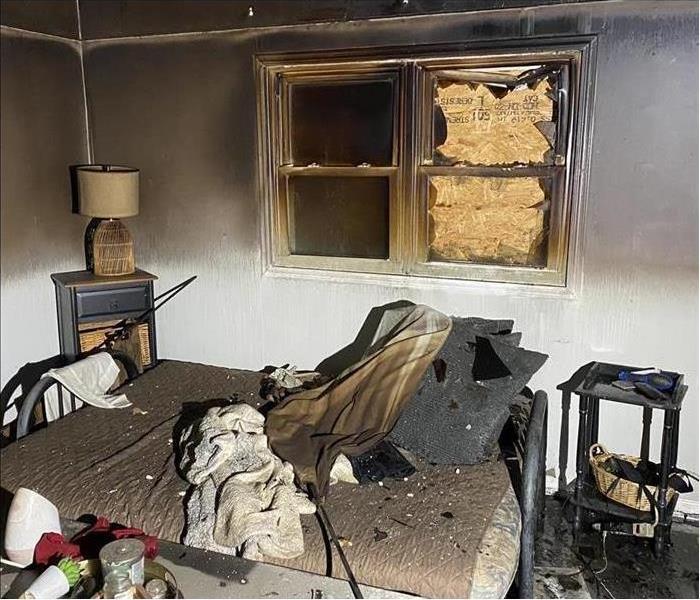 Residential fire in Bella Villa, MO.
Residential fire in Bella Villa, MO.
Three Ways Renters Insurance Helps After a Fire
A fire can quickly come out of nowhere and devastate your life and home. You might think you don't need to get insurance when you're renting because the homeowner's policy will cover everything in your Bella Villa, MO, home. However, their policy will cover the structure, not you and your things. Here are three ways renters insurance will help you after a fire.
1. Fire Damage to Personal Belongings
Whether from the flame, smoke or fire control methods, you'll find that your belongings suffer a lot of damage after a fire. Before you begin throwing anything away, it's essential to take pictures and keep a list of everything damaged in the fire. Your insurance company will work with you to reimburse you for everything up to your coverage limits. The insurance company will pay you the cost it would take to replace the item now, instead of how much you paid for it when you originally purchased it.
2. Liability for Damage to Others
Fires can quickly spread, causing damage to the buildings and people around you. If someone is hurt or their property gets damaged by fire from the property you lived in, your renter's insurance policy can help cover their expenses. The liability insurance will cover their medical costs and the expense of replacing any of their belongings that the fire destroyed.
3. Restoration Services
Even if the fire didn't burn something, that doesn't mean the item is still in usable condition. Smoke and soot can find their way into tiny crevices and cause irreparable damage if not quickly and adequately addressed. Your insurance policy will cover the cost of fire restoration services to clean and restore your items to like new, which can often be most cost-affordable than replacing them.
Even a small fire can ravage your life and your savings account. However, you'll have comfort knowing that you have less to worry about when you have renters insurance.
3 Things To Know About Flood Water
6/2/2022 (Permalink)
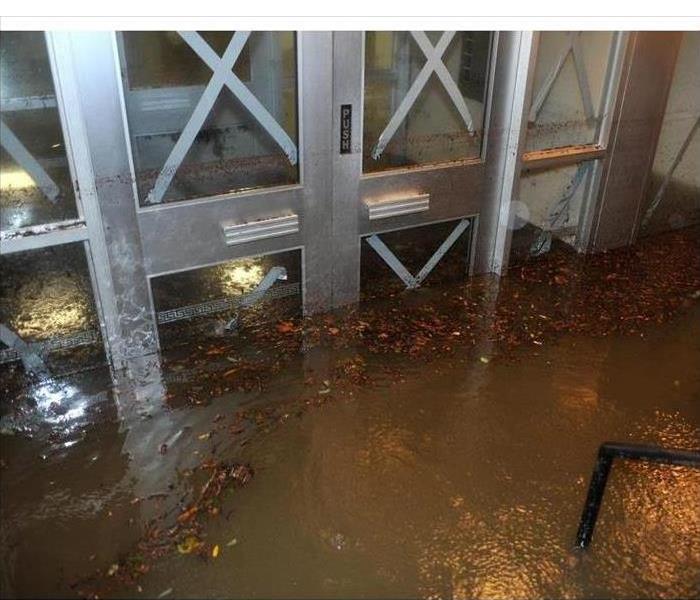 Flood water is classified as black water.
Flood water is classified as black water.
3 Things To Know About Flooding
When you have a storm approaching your White House, MO, business, there’s a risk of floodwater, causing potential damages. Any time this is a risk it’s important to know how to handle the cleanup and repair procedures. Here are three things you may need to know about flooding when preparing to clean up any damage.
1. Flooding Can Happen in a Number of Ways
There are a number of ways storm damage can lead to flooding. Gutters and downspouts can overflow flooding the roof, storm drains can back up, water can pool in low places in the yard and flow back toward the building, and windows or doors may leak.
2. Flooding is Black Water
It’s important to understand that floodwater is classified as black water. This means that there is a chance the water has come in contact with fecal matter meaning it may be contaminated with bacteria. This is why any time flooding occurs it’s best to contact a professional to ensure that proper cleanup and sensitization procedures are followed.
3. A Professional Should Handle Cleanup
Anytime you have flood-caused water in your business it’s highly recommended to contact a water damage restoration service. These professionals have the tools to remove the water, the training to inspect for the various damage types that may have occurred, and the ability to make any repairs. They should also be able to thoroughly clean and sanitize the space to remove and prevent the spread of any bacteria the water may have brought in.
When restoring flood damage on your company property it’s important to know the source of the flooding to ensure that there’s no further risk. It’s also important to remember that flood waterfalls are under the black category meaning they may be contaminated. This means that it’s best to have a professional do the restoration so they can ensure the affected space has been properly cleaned as well.
3 Tips for Flood-Proofing Your Business
5/25/2022 (Permalink)
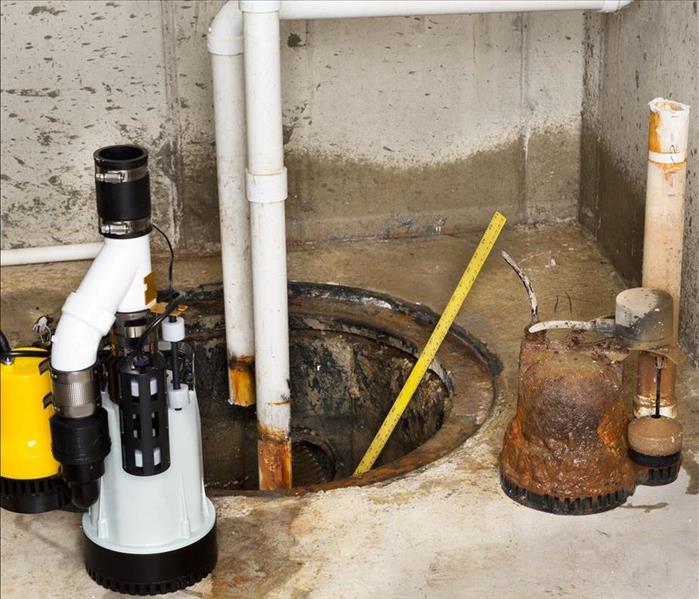 Sump pumps are useful for small floods or areas of your building, like basements, that frequently experience flooding.
Sump pumps are useful for small floods or areas of your building, like basements, that frequently experience flooding.
Flood Proofing Techniques
The damage that can occur to your business from flooding is no small matter. In fact, the National Flood Insurance Program claims that approximately 25 percent of businesses that have to close after a flood occurs never reopen their doors. For this reason, it is important you take measures to protect your company’s building against flooding if there is any risk of a storm or flood in Lemay, MO. While a water damage cleanup company can help restore your building to its original condition, it is important you are proactive in protecting your building and reducing costs ahead of time. Here are three useful tips for reducing flood damage to your business’ building.
1. Install a Sump Pump
Sump pumps are useful for small floods or areas of your building, like basements, that frequently experience flooding. They even make models with a backup battery in case storm damage causes the power to go out. They allow water to flow through the building and provide an outlet for it instead of allowing water to pool around the building and cause immense pressure.
2. Store All Important Items High Up
If you are in areas where flooding occurs often or have heard a flood might be on its way, make sure all important documents and electronics are on the top floor or at least raise them 18 inches off the ground. You can install shelves ahead of time to make this easier. The worse flood damage occurs to lower floors and basements.
3. Invest in Flood-Resistant Materials
For frequent floods, you should use flood-resistant materials that can handle being in contact with water for up to three days. If it is too costly to use these materials everywhere, at least make sure the bottom floor and basement use them.
Flood damage can ruin your company’s building and put you in a bad spot financially. Make sure you are prepared for the worst by trying out these flood-proofing techniques!
Tips When Dealing With Smoke Damage Insurance
5/18/2022 (Permalink)
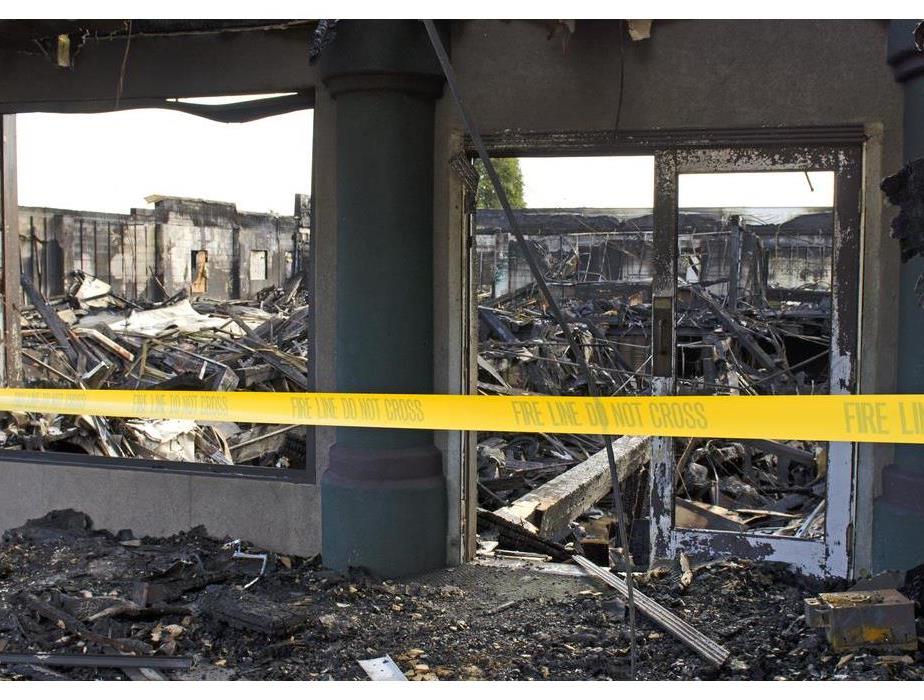 Commercial fire damage in Oakville, MO.
Commercial fire damage in Oakville, MO.
When Dealing With Smoke Damage Insurance, Here Are Some Pointers
Every commercial building owner needs to have insurance in the event of a disaster. Smoke damage could force your business to shut down operations. Even if you need to close for just a week, it could be enough for you to lose out on significant revenue. A thorough insurance policy can help tremendously with smoke cleaning costs and other essential expenses, and here are some tips for making sure you can have peace of mind in the event a fire ever occurs on your property in Oakville, MO.
1. Make Sure Your Insurance Covers Fires
All insurance policies are different. You need to make sure your specific policy covers fire damage. If you are presently unsure of what your policy covers, then you need to contact your agent to double-check. In the event you do not have any insurance that covers property damage, then you need to add it to your policy posthaste.
2. Be Detailed With Damage Documentation
A fire of any size will most likely cause some amount of smoke damage around the property. This documentation should include:- Location of damage
- Overall condition of the building
- Description of damaged items
- Date damage occurred
- Any injuries involved
You will need to provide all these details within a certain amount of time, so do it as quickly as possible. Make sure to take plenty of photographs as evidence.
3. Pay Professional Cleaning Experts
Another thing to take care of right after a fire to handle soot damage is to hire a professional remediation service. Without an expert, more damage could occur, and your insurance may not cover damage that technically occurs further down the line. Ultimately, you should pay for the cleaning service, and have your insurance agency reimburse you later.
You may not be able to prevent every fire, but you can increase your chances of recovering more successfully. Having a thorough insurance policy will be a major asset if you ever need to pay for smoke damage repairs.
3 Excellent Tips for Preventing Frozen Pipes
5/12/2022 (Permalink)
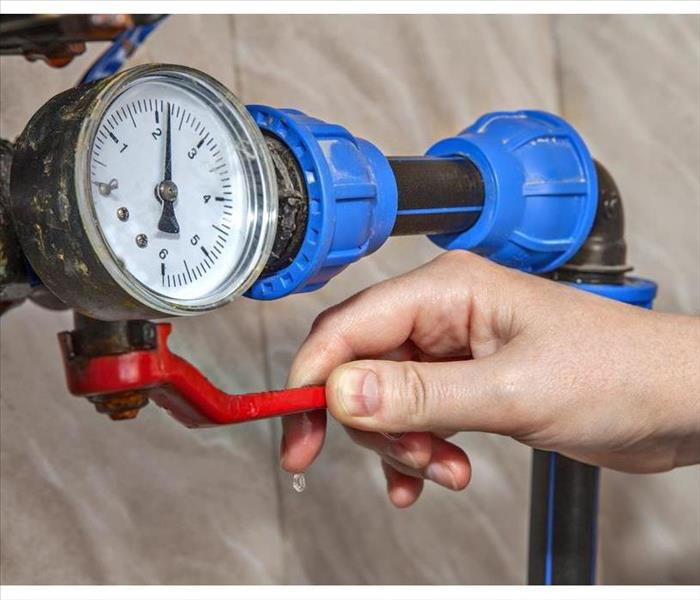 Turn off the main water valve.
Turn off the main water valve.
Stop Your Pipes From Freezing
Frozen pipes can end up being a serious disaster in your commercial building in Mehlville, MO. The pipe can end up bursting, spilling water everywhere and requiring immediate water line repair. Stop your pipes from freezing by following a few key tips that can potentially save you from disaster.
1. Turn on the Thermostat
The employees in the building will likely ask you to turn up the thermostat during the winter anyway, but you should consider having it running even when no one is in the office. The extra heat may be enough to stop the pipes from becoming frozen entirely. You need to ensure heat is allowed to disperse evenly, so open all interior and cabinet doors that may prevent heat from reaching certain pipes.
2. Acquire a Space Heater
Space heaters are normally used to keep you warm when you do not want to use your building’s heater. However, when the goal is preventing frozen pipes, you want to aim the heater toward pipes. Another way to stop pipes from freezing is to install a heating cable.
3. Turn Off the Main Water Valve
In the event people are going to be away from the office for a while, such as on holiday vacations, you do not want to come back to a flooded office. Therefore, it can be good to turn off the main water valve. The pipes may still freeze, but if they do, then the damage will be limited to the water left behind in the pipes.
These are a few of the things you can do to stop frozen pipes and flooding in your commercial building in Mehlville, MO. In the event your building has already flooded, then you need to get in touch with a professional water damage cleanup crew to handle the damage. At the end of the day, you should remember the old saying, “An ounce of prevention is worth a pound of cure.”
What Causes a Toilet to Leak When Flushing?
1/29/2022 (Permalink)
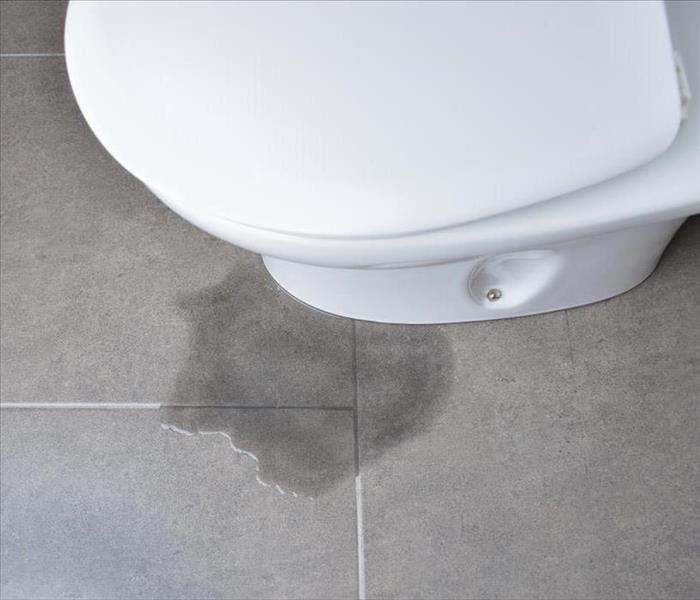 A leaking toilet in Lemay, MO.
A leaking toilet in Lemay, MO.
When you purchase a toilet in Lemay, MO, you expect it to last for years without giving it much thought. Then one day, you start noticing a bit of a leak around the floor and you may get upset and not know what to do about it. There are a few things you can check to discover the cause of a leaking toilet.
What to Check When Your Toilet Leaks
- Tighten the closet bolts holding the toilet to the floor
- If water still leaks out, you may need a new wax ring
- Inspect the bowl and base for cracks, even hairline could leak
Over time the closet bolts (white porcelain covered bolts at base of toilet) can work loose, allowing water to seep out between the base of the toilet and the wax ring. This is a simplest fix for a bathroom leak. Bolts should be tightened a bit at a time alternating sides to avoid cracking or an uneven seal. If this is the problem, you shouldn’t see any more leaking.
If the leak isn’t stopped by tightening the bolts, you may need to replace the weakened wax ring. Turn off the water supply, remove the closet bolts and unseat the toilet from the floor. Remove the old wax seal and replace it. Set the toilet in place and retighten the bolts.
If you still experience a bathroom leak, the toilet itself may need to be replaced. Check for cracks or fissures in the interior of the bowl. You may resist the thought of replacing the fixture but a leaking toilet can cost much more in the way of water damage to your home. Even a slow and steady leak can cause mold or rot in the floor boards and presents the possibility water leaking into the floor below.
A reliable emergency water damage service in Lemay, MO, can help to clean up and repair the damage “Like it never even happened.” Checking things out at the first sign of trouble can prevent the destruction of an ongoing leaking toilet and keep things sound and peaceful.
Failure To Do These Two Things May Increase Chances of Flood Damage to Your Home
1/11/2022 (Permalink)
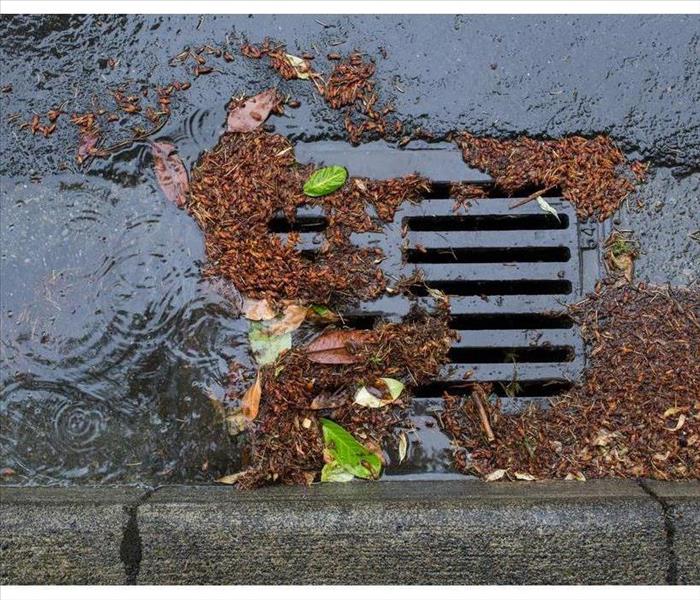 Make sure storm drains near your home are free of blockage. A blocked drain can cause flooding in your home.
Make sure storm drains near your home are free of blockage. A blocked drain can cause flooding in your home.
Did you know that even if you don’t live in a flood zone, failure to perform two simple things in Mehlville, MO, may result in flooding in your home? A clogged gutter can cause storm damage to your roof, walls, windows and doors. Likewise, a clogged or blocked storm drain at the curb or sidewalk can cause water to flood on the road and onto your property.
What Steps Can Be Taken To Avoid Flood Damage From a Blocked Storm Drain?
Here are two important steps to take that may reduce your chances of damage from a blocked storm drain.
1. Discard debris properly. Always discard raked leaves, straw, twigs, etc., in trash bags or grind them for use as mulch or compost. Avoid piling them on the street for pickup by your trash service.
2. Locate your storm drains. Know where the storm drains near your home are located and periodically monitor them. If you see them covered with debris, notify your city storm water management office in Mehlville, MO, so measures can be taken to remove the debris before a storm to avoid flooding.
How Do Storm Drains Get Blocked?
Storm drains can get blocked by debris, such as twigs, leaves, pine straw, etc., when it collects on top of the grate covering the drain, preventing rainwater from draining through the debris. As a result, the water may start to pool and back up into the street and/or surrounding property. If not caught soon enough, this pooling may result in a localized flood that not only has the potential to damage the outside of your property but may damage the inside of your home as well.
Sometimes, despite your best efforts, flooding may still occur. This is when you may need the assistance of a remediation company to assess the level of damage and provide options for cleanup. Making sure that your storm drains are clear could be your first step to safeguarding your property against a storm.
Partial Losses: Making an Insurance Claim
1/6/2022 (Permalink)
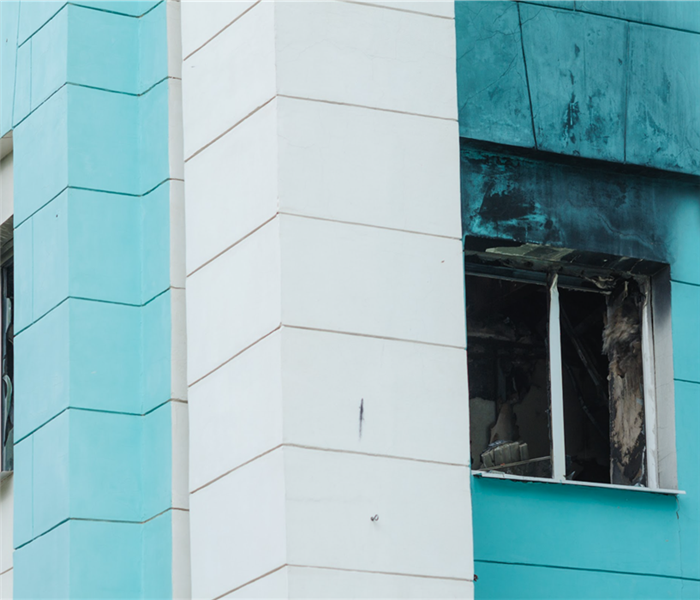 Commercial fire loss in Oakville, MO.
Commercial fire loss in Oakville, MO.
Common Questions About Partial Losses At Your Commercial Property
If your business sustained a partial fire loss recently, you may be wondering what the insurance claims process will entail. Here are common questions you may have about partial losses at your commercial property.
What Qualifies as a Partial Loss?
Any damage that did not completely destroy your building but still caused destruction is considered a partial loss. Some examples include:
- Damage that necessitates replacing unharmed items to restore uniformity
- Smoke damage to carpets, walls and other surfaces
- Items that did not burn but were still damaged by the fire
It can be hard to get your insurance company to take these kinds of damages seriously. Always insist on receiving the best assistance possible when talking with your agent or claims representative.
What Claims Process Should I Follow?
Here are the steps you need to take to properly file your partial fire loss claim:
1. File your claim early. Making sure to file your claim as quickly as possible after the damage occurs will help you in the long run. You will also have a better idea of what is and isn’t covered early on.
2. Record damages and expenses. Keep all receipts from repairs, snap photos of damage and keep documentation of any other steps in the restoration process. You may need them when you try to prove your financial and property damages.
3. Get professional help. An Oakville, MO, fire restoration service should be able to help you recover from smoke damage and other types of partial losses that may occur. A reliable company will take even small areas of destruction seriously and work out a cleanup plan that works for your business.
A fire loss of any size is a terrible thing to deal with, but a partial loss can present unique challenges that may prove to be frustrating for even the most level-headed business owner. Getting a great restoration team on your side and advocating for yourself with your commercial insurance provider are your best bets to receiving quality cleanup service and getting fairly compensated for your struggles.





 24/7 Emergency Service
24/7 Emergency Service




























